Learning a jazz standard or solo transcription can be a tricky process for any musician. But what many players forget is that you don’t have to tackle the entire piece of music at once…
The truth is, taking one small section of a tune and studying how your favorite players approach it in a solo is actually a much more effective path to take in the practice room.
And today we’re going to show you how to do exactly this over the tune Night and Day with one of the best improvisers out there…Kenny Garrett.
By examining how he approaches one section of a standard, you can easily isolate and absorb the specific musical concepts that he developed over time and add them to your own playing.
If you wanna play jazz, you have to study the music. The bebop, the ragtime, you have to study all those styles…and at least get a foundation…Because everything is coming from that energy. If you listen to my music, you will hear the root of Coltrane, Miles Davis, Duke Ellington, Freddie Hubbard, because that’s what I came through.
~ Kenny Garrett
Below we’ll take a look at how Kenny Garrett plays the ‘A’ section of a classic tune and the powerful musical concepts that are hidden inside of each phrase.
Let’s get started…
Cole Porter’s Night & Day
The jazz standard we’ll focus on today is Cole Porter’s 1932 classic Night and Day, in particular the ‘A’ section or opening 8 bars of the tune:
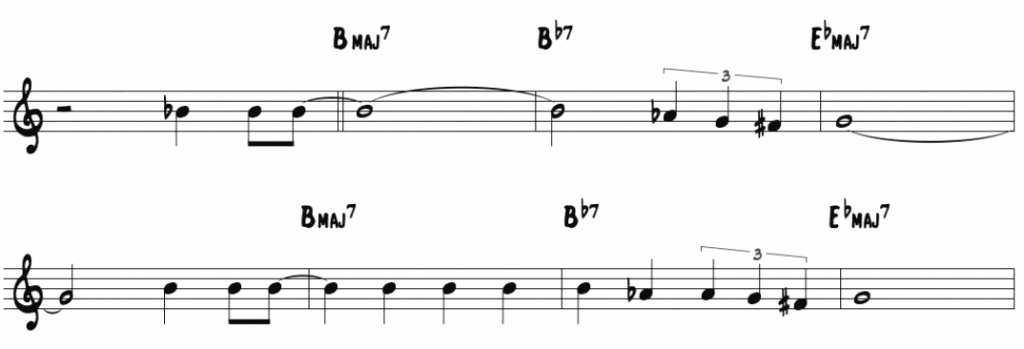
In this progression, Porter takes a unique approach by starting on the bVI chord:

The bVI (B) resolves by half-step to the V7 (Bb7) and eventually to the I chord – a novel substitution of the typical ii-V-I progression.
A variation that is commonly used on this tune is playing a iiø chord in the first bar and resolving to V7:

The bVI and iiø chords both share the B natural and Eb (D#) chord tones that resolve down to the Bb7 chord.
The version we’ll listen to today comes from Kenny Garrett’s 1995 album Triology with Charnett Moffett on bass and Brian Blade on drums:
On this recording the group approaches the A section as a diatonic ii-V-I…

Because they are playing in a trio format without a chordal instrument and just a bass note, there is more freedom to imply different chords.
*Make sure you learn the tune in its original form, along with the variations. For our purposes here, we’ll focus on Kenny Garrett’s version utilizing the ii-V-I.
5 Kenny Garrett Phrases
Now let’s examine how Kenny Garrett approaches the first 8 bars of Night and Day throughout his solo – starting with his interpretation of the melody and then isolating 5 specific phrases that showcase a different musical concept.
Melodic Interpretation
The first step in learning to improvise over any tune or its chord progression starts with the melody…

And once you learn that, the next step for any soloist is interpreting the melody in your own way.
A great way to develop this skill is to study how a great player interprets each phrase of the melody. Remember, it doesn’t matter how subtle each interpretation may be, there are details and musical techniques that you can absorb into your own playing.
Let’s listen to how Kenny Garrett interprets the melody on the first 8 bars…

Notice how Garrett utilizes space and syncopation to transform the melody and how he delays and anticipates certain phrases.
Now check out how he plays the melody the second time through:

Again he utilizes space, rhythmic freedom, and embellishes the melodic line with a few extra notes. The same basic melodic line is retained, just interpreted in a unique way.
The basic ideas comes down to this: You have an 8 bar phrase…now how are you going to shape this melody and make it creative and musical?
Think of interpreting the melody as the first step on your journey to improvising over a tune. In doing this you are starting with a musical phrase rather than a mishmash of chords and scales, and this will translate to your improvised lines.
Now let’s take a closer look at 5 musical concepts Kenny Garrett uses to improvise over these eight bars of music…
#1) Mirror the melody

In the opening to his solo, Garrett plays the following line:

He is improvising with the original melody in mind, retaining the overall phrase and original characteristics – an initial repeated note, motion on the V7, and resolution to the I. But here he changes the rhythm and chord tones, emphasizing #9 of V and resolving to 6th of I chord:

You can think of this line like an altered version of the melody with more harmonic tension, in a way moving the melody up a minor 3rd:
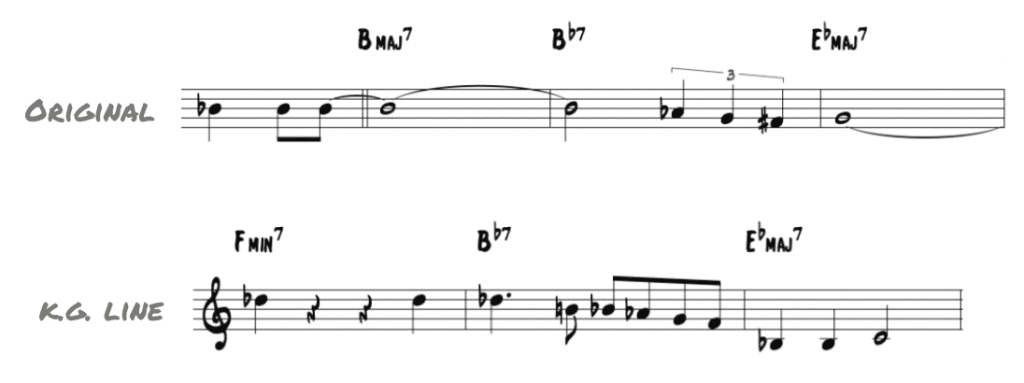
Another concept to note here is how he treats the ii-V to I as V7 to I – i.e. you don’t have to play the ii chord. Simplifying the progression and just focusing on the V7 to I relationship:

Over this you can apply any V7 to I techniques or even altered V7 ideas that resolve to I. The idea is to zero in on the basic tension to resolution of this relationship, thinking Bb7 to Eb Major.
In the practice room, you can use Kenny’s phrases as a starting point…


As you think about the progression, visualize each four bar ii-V-I in the A section as the V7 to I and apply these ideas in creative ways.
#2) Quote A melody

Great improvisers have used the technique of quoting melodies in their solos , from Charlie Parker to Dexter Gordon to the players of today.
In essence, it’s the approach of using an existing melody to create more melodic ideas for your own solos…
And in this next phrase, Garrett uses this tactic with a specific tune in mind:
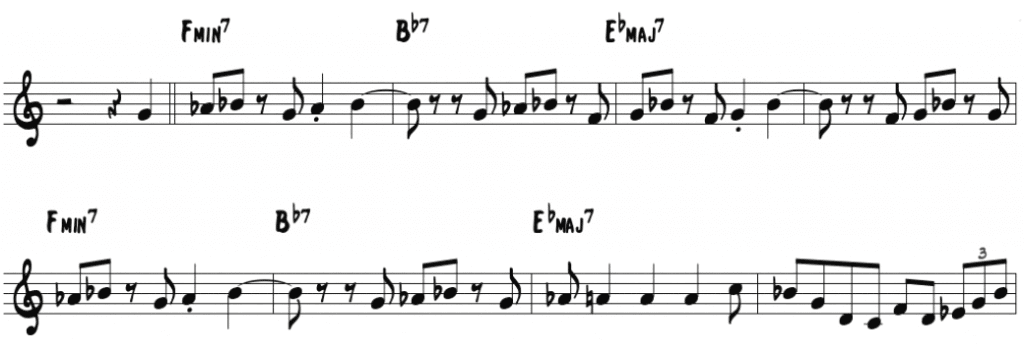
Here he quotes the melody of Juan Tizol’s Perdido, which is also written over a ii-V-I progression…

Garrett slightly alters the melodic content of the line and ends the phrase with the #11 over the Eb Major chord before resolving.

This technique is a great way to develop a melodic approach to any progression. Rather than using music theory, think of a melody that you know and use it as the starting point for your improvisation!
#3) Utilizing patterns

Another melodic trick that Kenny Garrett employs in many solos is the use of patterns…and the line below is no exception.
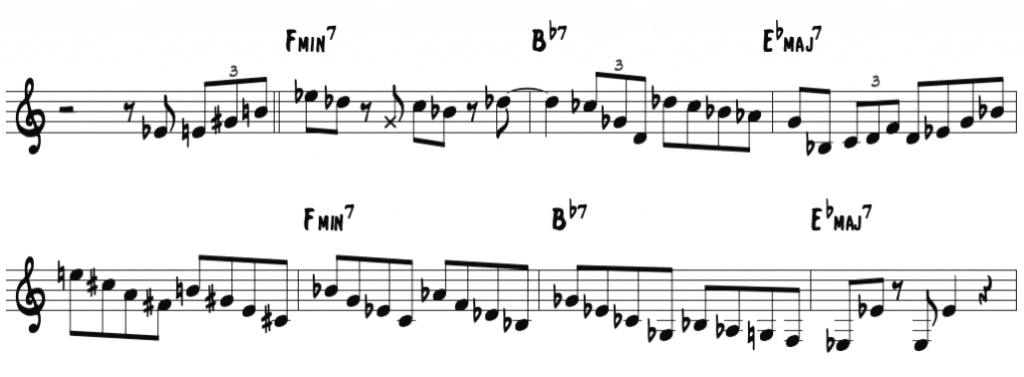
If you look at the second four bars of the line, Kenny quickly moves from Eb major to a descending F#-7 arpeggio:
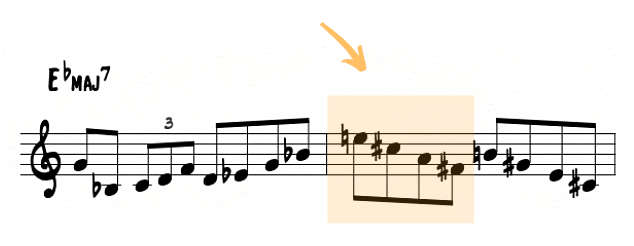
And this begins a descending minor arpeggio pattern that eventually resolves back to the I chord:

From the F#-7 arpeggio and moves down a 4th to C#-7 which is a common pattern often played by musicians like Freddie Hubbard. And from there he descends stepwise from C- to Bb- to Ab- and then implies a Bb7 before resolving to the tonic, Eb major.
Employing patterns like this are a useful way to step outside of the chord progression, the trick is knowing where to begin and how to resolve back to the established harmony!
#4) Play over the tonic

In this line, Garrett takes a simplified approach to the repeating ii-V’s in the chord progression:
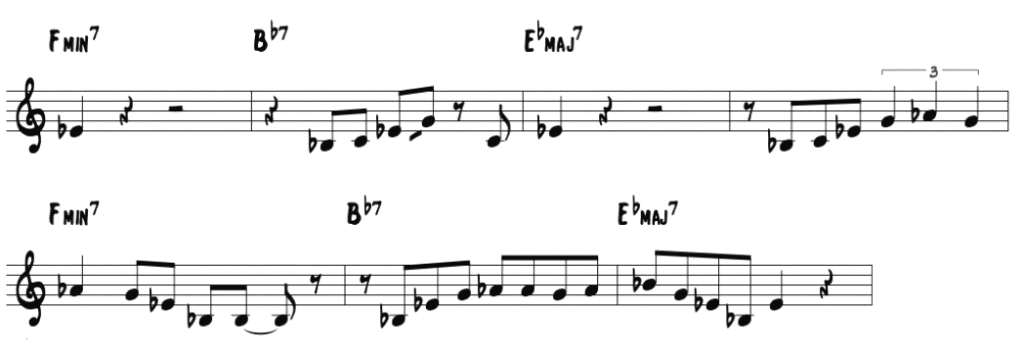
Rather than focusing on every single chord in the progression, he plays the tonic chord (the I), treating the entire sequence as an Eb Major chord.

Over this you can create melodic ideas in the home key, utilizing major language and techniques. One simple way to create ideas over major is to start with the triad and add another chord tone.
Garrett does this in two ways, using the root triad plus the 6th:
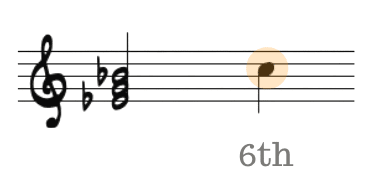
And using the root triad plus the 4th:
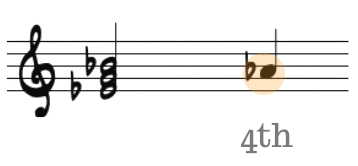
For example, in this line you can hear him playing an Eb triad with the 6th:
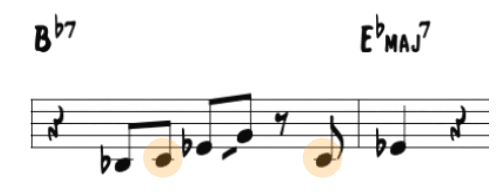
And in this line the triad plus the 4th:

Try this technique over any ii-V-I, playing the I chord over the entire progression and utilizing the tonic triad with an additional note.
Phrase #5: A triadic Sequence
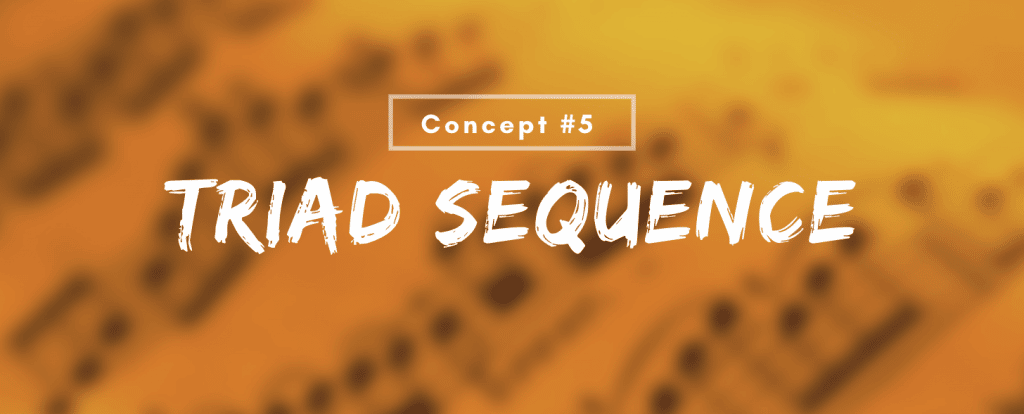
In the last phrase we’ll look at, Garrett again utilizes a musical shape that he shifts around by whole-steps…

Taking one musical device and building his phrases around it. In this case a major triad on the tonic, Eb:

He then moves this rhythmic pattern using triads up by whole-steps, starting on the tonic triad and ascending:
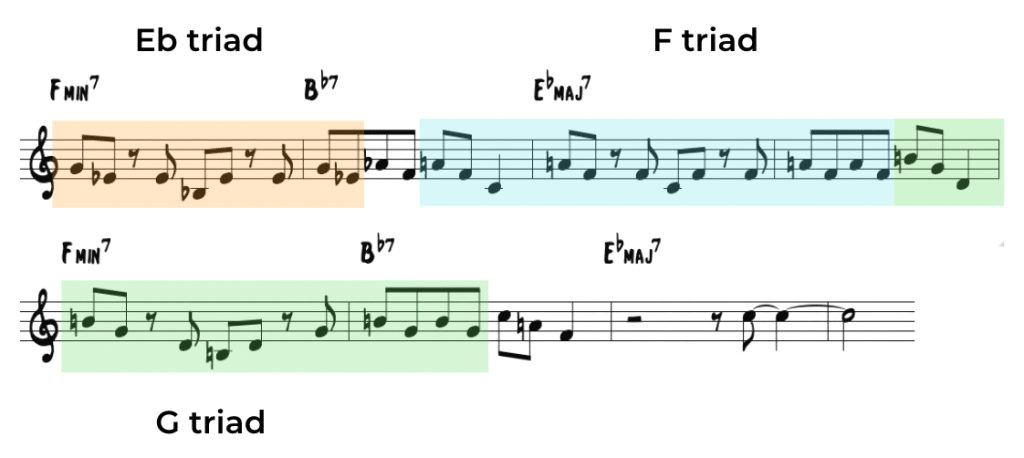
He is not so much worried about individual chords as he is the bigger picture, starting in the home key and progressively adding tension. Each triad successively adds more dissonance – the F triad introducing the #11 and the G triad using the #5…

Thinking of the entire 8 bar phrase as one unit rather than individual chords, and aiming for the resolution at the end.
Take it One step at a time
Each of the musical concepts we outlined above can be powerful tools in creating your own musical approach to a tune.
The trick now is to study and ingrain each of them into your playing in the practice room:
- Mirror the melody
- Quote a tune
- Apply sequential patterns
- Simplify the chord progression
- Utilize melodic shapes in sequence
Mastering a few musical concepts like these will allowyou to transform even the most common chord progressions and tunes into opportunities for improvised creativity!










